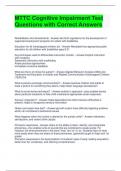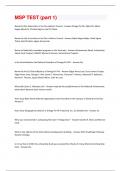MTTC Cognitive Impairment Test
Questions with Correct Answers
Rehabilitation Act Amendments - Answer-Set forth regulations for the development of
supported employment programs for adults with disabilities
Education for all handicapped children act - Answer-Mandated free appropriate public
education for all children with disabilities ages 6-21
Key techniques used to differentiate instruction include: - Answer-Explicit instruction
with modeling
Systematic instruction with scaffolding
Ample practice opportunities
Immediate corrective feedback
What are the tx of choice for autism? - Answer-Applied Behavior Analysis (ABA) and
Treatment and Education of Autistic and Related Communication Handicapped Children
(TEACCH)
What is picture exchange communication? - Answer-teaches children and adults to
trade a picture for something they desire, helps foster language development
What is social stories technique? - Answer-autistic tx approach- uses scripted stories
about particular situations to help child understand appropriate social responses.
Sensory integration? - Answer-helps desensitize the child if sensory difficulties is
present, helps to reorganize sensory information
Gluten and casein free diet? - Answer-ppl with autism have difficulty digesting proteins,
which can contribute to behavioral issues
What happens when the routine is altered for the autistic child? - Answer-withdrawn,
self-abusive, and violent (think Jacob)
Phonemic awareness - Answer-refers to the ability to listen, identify, and manipulate
phonemes—the smallest units of sounds that are combined to create words. For
instance, the three phonemes in the word "mop" are /m/ /o/ /p/. Students learn to read
more easily when they are aware of these phonemes. (generally taught in Kdgn and 1st
grade)
Phonemic awareness is the best predictor of students' ease of early reading acquisition,
better than IQ, vocabulary, and listening comprehension.
,Note: Phonemic awareness is not the same as phonics. Phonemic awareness relates
exclusively to spoken sounds. Phonics, on the other hand, corresponds to how spoken
sounds are represented in written text.
Phonics - Answer-the ability of students to sound out printed words will unfold as
teachers instruct them in the relationship between letters, sounds, and written language.
It is best to begin teaching sound-to-print associations that are easiest for students to
pronounce, read, and comprehend. Letters should be introduced so that students can
quickly blend the sounds into words that they can read. For example, after s, m, t, and a
have been introduced, students can read "am," "Sam," "at," "sat," and "mat."
Fluency in reading - Answer-Refers to an ability to read text with accuracy, speed, and
intonation.
Studies show that fluency and reading comprehension skills are closely related.
Nonfluent readers work so hard at decoding individual words in a sentence that they
end up not comprehending what they have read.
Fluency develops when students practice reading and rereading words, passages, or
other texts with a high degree of success. Students should practice reading fluency to
increase their decoding and word-recognition skills. (teach second half of 1st grade thru
3rd grade- gen ed)
Fluency Reading Instruction (helps with comprehension)
http://iris.peabody.vanderbilt.edu/module/rti03-reading/cresource/what-components-
comprise-high-quality-reading-instruction/rti03_06/#content - Answer-Repeated Reading
- A student reads the same passage multiple times until fluency is achieved.
Using Technology- A student uses a computer or other equipment, such as a tape
recorder, to assist with fluency.
According to Lev Vygotsky's theory of social development, the zone of proximal
development is... - Answer-the distance between a student's ability to perform a task
guided by an adult or collaborating with a peer and the student's ability to perform that
task independently. Vygotsky identified this zone as the area wherein learning takes
place. The adult or peer who helps the student is the More Knowledgeable Other
(MKO);
Which of the following statements is true regarding individuals with autism spectrum
disorders? - Answer-some people with autism spectrum disorders have mental
retardation and some do not
About 50 percent of persons diagnosed with some form of autistic disorder are also
diagnosed with mental retardation, while the other half has normal IQ scores; of these,
many are highly intelligent.
Which of the following is not an assessment type on MI-Access, a Michigan state
alternative assessment for students with disabilities? - Answer-As of 2005, MI-Access
, did not include an assessment for students with "profound" cognitive impairment. MI-
Access does include Interim Phase 2 BRIGANCE, a commercial test tailored for
Michigan students demonstrating mild cognitive impairment; Supported Independence,
an assessment for students functioning at the moderate level of cognitive impairment;
and Participation, an assessment designed for students who demonstrate severe
cognitive impairment.
Which of the following is true regarding the of Scales of Independent Behavior-Revised
(SIB-R), the standard form of the Vineland Adaptive Behavior Scales, the American
Association on Mental Retardation (AAMR) Adaptive Behavior Scales (ABS), and the
Inventory for Client and Agency Planning (ICAP)? - Answer-These tests all supply
intercorrelations among their own different subscales to show relationships among their
individual test components.
It is not true that they all give comparison scores between students with and without
disabilities. Only the SIB-R and the ICAP provide this information for age-matched
populations. None of the four tests give discriminant analyses to aid with school
placements and determining level of mental retardation (MR); again, only the SIB-R and
the ICAP supply these. Therefore, it is not true that these tests all incorporate all of
these components.
According to the IDEA 2004 law, when do students become involved in their own
transition planning as a part of their IEP (Individual Education Plan)? - Answer-
According to IDEA (Individuals with Disabilities Education Act) 2004, students become
involved in their own transition planning, which is included in their IEPs, when they
reach the age of 16. At this age, students are also expected to sign their IEPs. The
1994 IDEA mandated beginning transition planning when the student reached the age
of 14, but this was changed in the newer version of the law. Educators, parents, and
students are still encouraged to begin transition planning when the student is 14, as it
can take several years with some students, but it is not legally required until the student
is 16.
# 1 Example of a 36 month old child showing language delay - Answer-B. 36 month old
child has an oral expression vocab of 20 words and does not combine words in her
speech
# 2 A third grade autistic student will most likely show difficulty with the following task -
Answer-A. working cooperatively with other students on class projects
# 3 a leading prenatal cause of cognitive impairments is - Answer-C. exposure to
substance abuse
# 4 teaching mild to moderate c.i. students to cross the street with these steps (stop,
look, listen, walk) is successful if - Answer-D. students practice as often as possible in
the actual setting where they will use these steps





